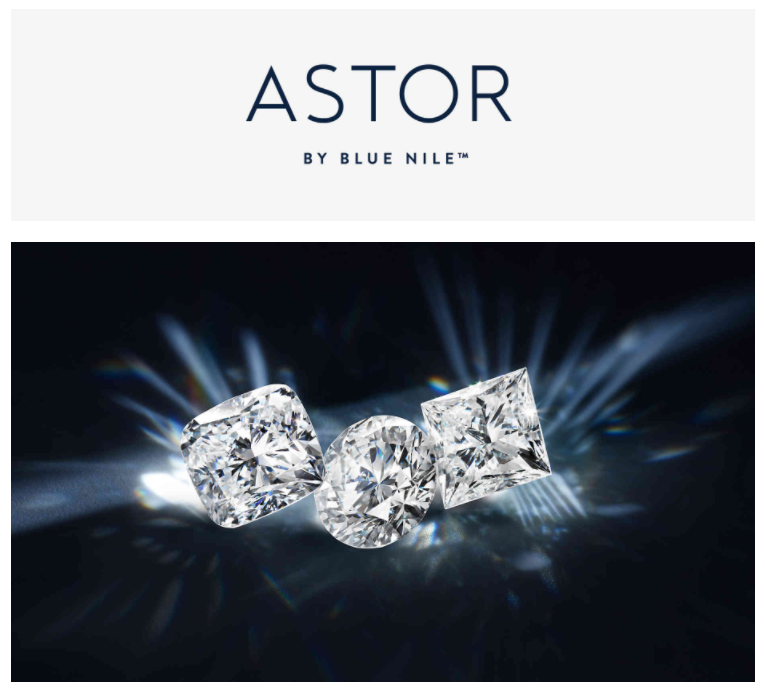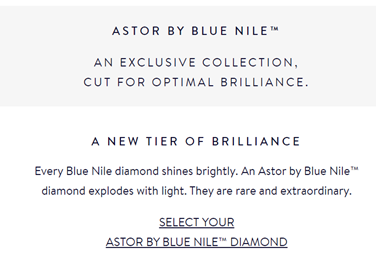This article has mentions of products from one or more companies, and I may receive compensation if you purchase those products following reading my recommendations.

Blue Nile first found success over two decades ago and are widely considered the pioneers of the online diamond retail market. Offering buyers the chance to view thousands of ‘virtual’ (i.e. not in-stock) diamonds, they opened the doors to a new way of buying fine jewelry and offered fantastic prices to their customers. You can read my full review of the Blue Nile company here.
While Blue Nile no longer dominate the online diamond scene in the same way, however they do strive to keep up with their competitors. As the average buyer becomes more informed and as technology continues to improve, a focus on cut quality is now essential for all vendors worth their salt; specifically, super-ideal cut or in-house specialist diamonds are now highly desired by buyers across the globe.
I have reviewed the Astor diamonds by Blue Nile to see if their claims of ‘a new tier of brilliance’ are substantiated.
What is an In-House Diamond?
An in house or in stock diamond are inventories that are actually owned and housed by the merchants offering them. The vast majority of online vendors have “virtual” inventories, i.e James Allen and Blue Nile. Some vendors like Whiteflash have their diamonds in-house that are fully evaluated, on-hand, and ready for immediate delivery or in-store viewing.
The diamonds are analysed before being granted an in-house title. Sometimes these specifications are vague and loose, but the in-house diamonds of good vendors will meet scrupulous standards and offer something truly remarkable. The Astor by Blue Nile are in-house diamonds, however their other collections are not.
Astor by Blue Nile: The Good
Starting with the positives. It is great that Blue Nile offer a collection that claims to focus on cut quality. Cut is the most important factor of diamond buying; thus, I commend any company who attempts to put this crucial feature front and centre for customers.
The Astor diamonds encompass more than the round brilliant; Princess and Cushion cut diamonds can also hold the Astor title, should they meet the specifications. But what are those specifications exactly? Well, this is where things go a little downhill.
Astor by Blue Nile Specifications
A standard has been clearly set for in-house diamonds, not only in terms of the diamond quality but in terms of the transparency of their specifications. I must hold Blue Nile to the industry standard; the A CUT ABOVE® diamonds by Whiteflash.
This review isn’t about A CUT ABOVE® diamonds (you can read that review here) but with incredibly detailed and transparent specifications and performance reports, that is where the bar is. Let’s take a look:

This is our first introduction to the Astor Diamonds and it certainly sounds promising. Rare, extraordinary and exploding with light – this description is certain to capture the imaginations of buyers.

Blue Nile then mention that Astor diamonds receive ‘dual evaluations’. The first is a GIA report – no extra points here. A GIA or AGS report is a must for all diamonds. A GIA report also doesn’t guarantee a beautiful diamond, rather it promises that grades will be accurate and consistent.
The second is a GemEx®. GemEx® essentially offer light performance analysis that measures brilliance, fire and ‘sparkle’. Amongst diamond experts, GemEx® carries little to no weight and is merely a sales tool. To really understand light performance, ASET and Idealscope images are far superior.
Blue Nile neglect to mention exactly what the GIA reports or GemEx® certificates should show. There is no mention of finer details such as measurements, angles or proportions. Most of the Astor Diamonds hinge on a weak promise of a diamond that ‘explodes with light’, but with absolutely no evidence to back this up.
This is poor show from Blue Nile, particularly as their previous collection of in-house diamonds (the Signature collection) provided more information about diamond specifics. It is a step backward for the former industry leaders.
Astor Diamonds: Quality
I have analysed several diamonds from the Astor collection. They are not super-ideal cuts and there is not a great deal of consistency in cut quality across the collection. In fact, some Astor diamonds actually score pretty low when it comes to light return, regardless of what the questionable GemEx® cert might suggest.
Should I Buy an Astor Diamond?
If you really know your diamonds, I have no doubt you could trawl through the Astor collection, comparing diamond certifications and proportions, scrutinising diamond images and eventually find a knockout – but that begs the question – why have an in-house collection at all?
Aside from proven performance and superior quality, part of the appeal of an in-house diamond is that much of the work has been done for you. Given that in-house diamonds carry premiums, it is fair to expect that you could select any diamond from an in-house collection and be onto a winner. You pay for the quality and the expert scrutiny that the diamond has undertaken. You pay for the black and white specifications and the promise that the diamonds reach them.
Inconsistency, a total lack of specifications and a general negligence when it comes to informing customers mean I cannot recommend Blue Nile’s Astor diamonds. I am a huge fan of Blue Nile in general; their imaging and inventory cannot be argued with and they also hold wonderful designer settings. However, a truly remarkable in-house diamond requires a level of care and attention that Blue Nile are not reaching.
